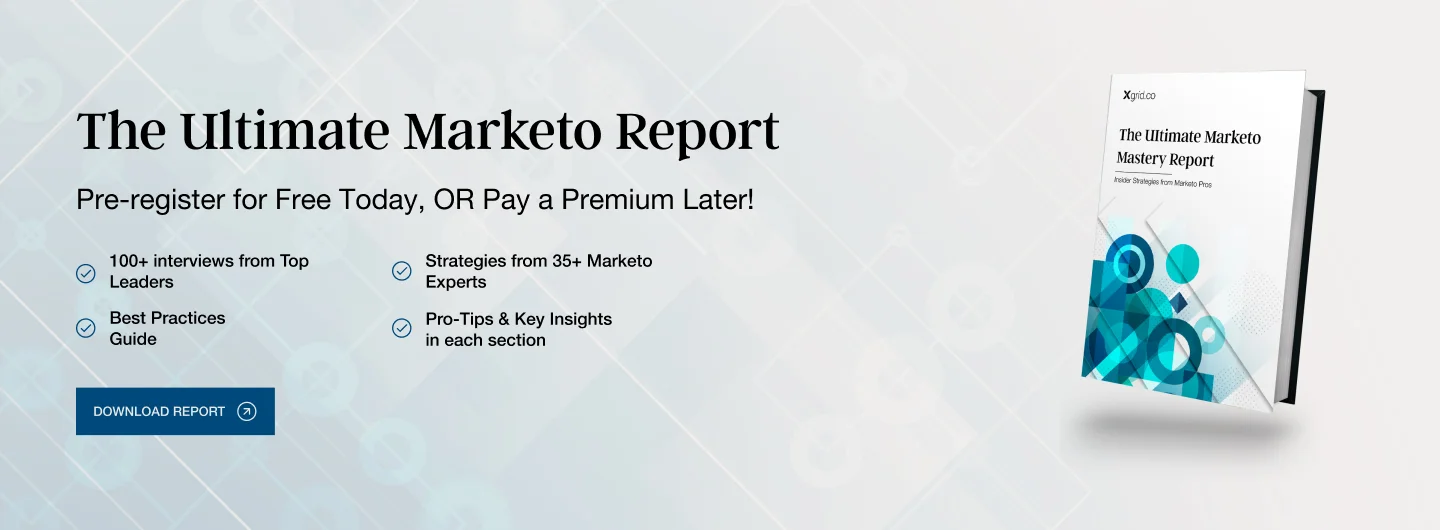Marketo Instance Audit: Guide to Optimizing Your Marketing Automation
A Marketo Instance Audit is a comprehensive review of your Marketo environment, designed to identify areas for improvement and optimize your marketing automation efforts. By conducting regular audits, you can ensure your instance is:
- Efficient: Eliminating unnecessary processes and optimizing configurations for better performance.
- Effective: Driving increased ROI through data-driven decisions and improved campaign performance.
- Compliant: Maintaining data privacy and adhering to relevant regulations.
When to Conduct a Marketo Instance Audit
Several situations call for a Marketo Instance Audit:
- New Marketing Team: If you have a new team taking over Marketo management, an audit can provide a clear understanding of the current state and identify any areas that need immediate attention.
- Declining Campaign Performance: Are your campaigns underperforming? An audit can help pinpoint potential issues like targeting inaccuracies, outdated content, or inefficient workflows.
- Platform Migration: Migrating to a new marketing automation platform? An audit of your current Marketo instance can identify valuable data and assets to migrate and ensure a smooth transition.
- Regular Reviews: Even without any specific concerns, conducting regular Marketo Instance Audits (e.g., quarterly) is a proactive approach to maintaining a healthy and optimized instance.
Preparation and Planning
Before diving in, define your audit objectives. Are you looking to:
- Boost campaign performance: Increase conversion rates, improve lead quality, or enhance email engagement?
- Ensure data hygiene: Cleanse your lead database, eliminate duplicates, and standardize data formats?
- Guarantee compliance: Adhere to data privacy regulations like GDPR and CCPA?
Identifying key stakeholders is crucial. Include marketing managers, operations teams, data analysts, and anyone who interacts with Marketo. Gather existing documentation related to your setup, including process workflows, integration details, and data schemas. This provides a baseline for your audit.
Data Quality and Management
A clean and well-managed lead database is the foundation of successful marketing efforts. Here’s what to focus on:
- Lead Database Review: Identify and eliminate duplicates. Utilize Marketo’s de-duplication tools or consider third-party solutions like RingLead or DemandTools. Address incomplete records by filling in missing data or removing irrelevant entries. Flag and update outdated information to ensure data accuracy.
- Segmentation Accuracy: Review your segmentation criteria. Are they still relevant to your current marketing strategies? Update and refine segment definitions to target the right audiences with the right messages.
- Data Standardization: Verify that data fields are consistent across the board. Ensure consistent formatting for phone numbers, addresses, and other crucial data points. This helps maintain data integrity and facilitates accurate reporting.
Action Steps:
- Schedule a dedicated session for data cleansing activities.
- Set up automated processes to identify and flag duplicate records.
- Implement data validation rules to ensure data accuracy upon entry.
- Review and revise segmentation criteria based on current marketing goals.
- Develop a data standardization guide for your team.
Campaign and Program Analysis
Take a deep dive into your active campaigns:
- Review for Relevance: Are they still aligned with your current marketing objectives? Deactivate outdated campaigns that no longer contribute to your goals.
- Program Template Audit: Ensure program templates adhere to best practices and are used consistently across your marketing initiatives. This promotes a cohesive brand experience.
- Engagement Program Analysis: Analyze nurture tracks and other engagement programs to identify areas for improvement. Look for opportunities to personalize content, optimize email cadences, and increase lead engagement.
Action Steps:
- Prioritize campaigns based on relevance and performance.
- Develop a process for regularly reviewing and updating program templates.
- Analyze engagement metrics for nurture tracks and identify opportunities for improvement.
- A/B test different email cadences and content variations to optimize engagement.
Automation and Workflows
Smart campaigns are the backbone of Marketo automation. Review them for efficiency and effectiveness:
- Smart Campaign Review: Double-check that triggers, filters, and flow steps are configured correctly. Ensure smooth execution and avoid sending irrelevant communications.
- Operational Campaign Check: Verify the accuracy and performance of operational campaigns, such as data management workflows. This maintains data organization and accessibility.
- Lead Scoring Audit: Ensure lead scoring models align with your current sales and marketing criteria for optimal lead qualification. Consider factors like website activity, engagement with marketing content, and firmographic data.
Action Steps:
- Document the logic and purpose of each smart campaign.
- Standardize naming conventions for smart campaigns for better organization.
- Test your smart campaigns thoroughly before activation.
- Review and update lead scoring models based on current marketing and sales objectives.
Email Marketing
Email marketing remains a cornerstone of digital marketing success. Here’s how to optimize your email efforts:
- Email Deliverability Check: Identify and address potential issues with spam filters or blacklisting that could be hindering email delivery rates.
- Email Template Review: Ensure email templates are visually appealing, mobile-responsive, and adhere to your brand guidelines. This enhances user experience and brand recognition.
- Performance Metrics Analysis: Analyze open rates, click-through rates, and conversion rates to gauge the effectiveness of your email campaigns. Use these insights to refine your messaging, subject lines, and calls to action.
Landing Pages and Forms
Landing pages and forms are critical for converting website visitors into leads. Here’s how to optimize them:
- Landing Page Performance Review: Analyze landing page performance metrics such as conversion rates and bounce rates. Identify low-performing pages and investigate reasons for drop-off. Consider A/B testing different page elements like headlines, CTAs, and content to improve conversion rates.
- Form Optimization: Ensure your forms are user-friendly and minimize friction in the conversion process. Eliminate unnecessary fields, optimize form layout for mobile devices, and provide clear instructions.
Action Steps:
- Prioritize landing pages for optimization based on traffic volume and conversion potential.
- Develop a testing plan for A/B testing different landing page elements.
- Analyze form completion rates and identify opportunities to reduce form abandonment.
- Implement progressive profiling to collect additional data gradually over time.
Integration and API
Seamless integration with your CRM and other marketing tools is essential for a unified customer experience. Here’s what to check:
- CRM Integration Verification: Verify that data syncs between Marketo and your CRM are functioning flawlessly, with no discrepancies. Ensure two-way data flow to maintain a complete customer profile.
- Third-Party Integration Review: Review other third-party integrations to ensure they are up-to-date and functioning as expected. Update any outdated integrations and consider the need for new integrations to streamline your marketing workflows.
- API Usage Check: Analyze API usage for any errors or performance issues. Identify bottlenecks and optimize API calls to maintain efficient data exchange.
Action Steps:
- Document the configuration details for each integration.
- Set up automated alerts for any errors or disruptions in data synchronization.
- Evaluate the need for additional integrations to enhance your marketing capabilities.
- Develop guidelines for API usage within your organization.
Security and Compliance
Data security and compliance are paramount concerns in today’s digital landscape. Here’s how to ensure your Marketo instance is secure:
- User Permissions Review: Review user roles and permissions to ensure they are appropriate and updated. Grant access based on the principle of least privilege to minimize the risk of unauthorized access.
- Data Privacy Compliance: Verify that your Marketo instance adheres to data privacy regulations like GDPR and CCPA. Implement appropriate safeguards to protect user data and manage opt-in/opt-out preferences.
- Audit Log Monitoring: Regularly check audit logs to identify any unusual activities or potential security breaches. Take prompt action to address any suspicious activity.
Action Steps:
- Develop a data security policy for your organization.
- Conduct regular user access reviews and revoke access for inactive users.
- Implement multi-factor authentication for additional security.
- Train your team on data privacy regulations and best practices for data handling.
Reporting and Analytics
Performance dashboards and reports are crucial for tracking the effectiveness of your Marketo efforts. Here’s what to focus on:
- Performance Dashboard Review: Ensure your performance dashboards provide meaningful and actionable insights. Customize dashboards to reflect your key marketing objectives and KPIs.
- Custom Report Audit: Review custom reports for accuracy and relevance. Update outdated metrics or KPIs to track the most critical data points for your marketing goals. Consider the use of segmentation to gain deeper insights into specific audience segments.
Action Steps:
- Define key marketing performance indicators (KPIs) for your Marketo initiatives.
- Develop a reporting schedule for generating regular reports on campaign performance.
- Use data visualization tools to present complex data in an easily understandable format.
- Share key insights from reports with stakeholders to inform future marketing decisions.
Documentation and Training
A well-documented Marketo instance is essential for efficient team collaboration and knowledge transfer.
- Documentation Update: Ensure all processes and workflows are clearly documented for future reference and team onboarding. Update existing documentation to reflect any changes made as a result of the audit.
- Training: Provide training for team members on any new processes or tools implemented as a result of the audit. This empowers them to leverage Marketo to its full potential and ensures consistent best practices across your marketing team.
Conclusion
A comprehensive Marketo Instance Audit has shone a light on your marketing automation platform’s strengths and weaknesses. Now you have a roadmap for optimization, ensuring your Marketo instance operates at peak efficiency.
However, tackling these optimizations in-house can be time-consuming and resource-intensive, especially for complex issues. This is where outsourcing to Marketo experts can be a strategic decision.
Marketo specialists possess the deep technical knowledge and experience to streamline your instance, maximize its capabilities, and ultimately, unlock the full potential of your marketing automation efforts. They can handle tasks like:
- Streamlining configurations and workflows
- Optimizing data hygiene and segmentation
- Enhancing campaign performance and reporting
- Integrating Marketo with other marketing tools
By outsourcing to Marketo experts, you free your internal team to focus on core marketing initiatives while ensuring your Marketo instance operates smoothly and delivers exceptional results.






